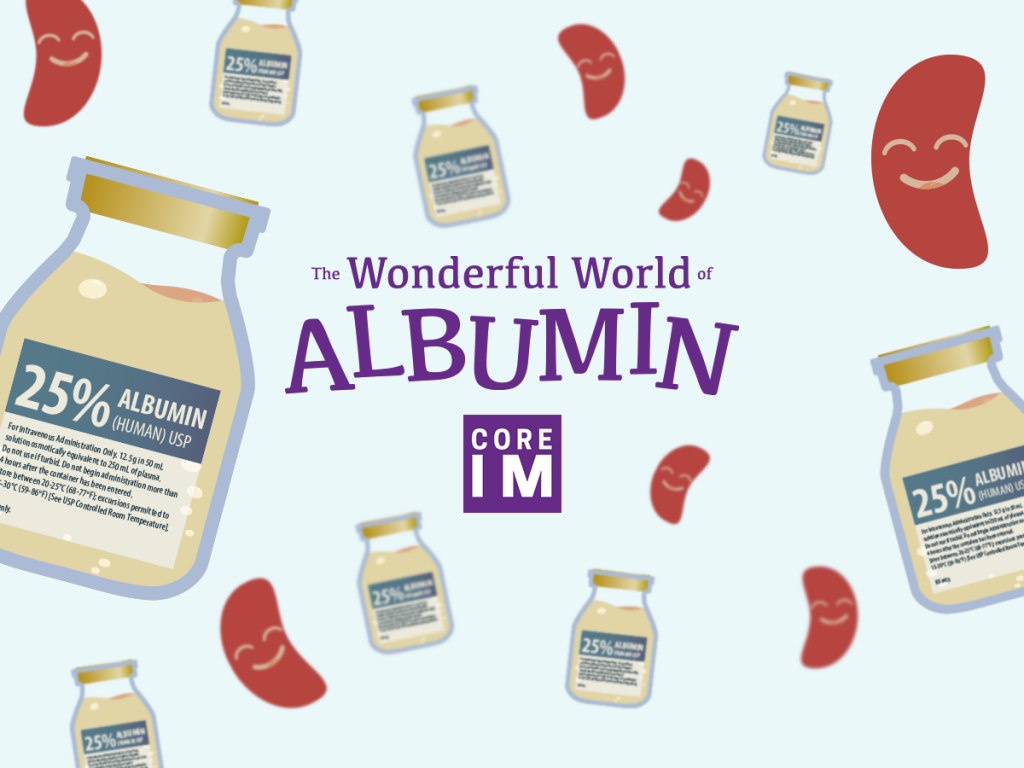Podcast: Play in new window | Download
Subscribe: RSS
Let’s go deeper as to why we do what we do: albumin in spontaneous bacterial peritonitis (SBP)! Written by Dr. Steve Liu || Hosted by Dr. Steve Liu and Janine Knudsen || Graphic Design by Mr. Ramon Thompson (Twitter @newsaturdayds || @newsaturday)
Time Stamps:
- How much albumin is recommended in  SBP? (1:45)
- What antibiotics are used for treatment of SBP? (2:30)
- Why do we give albumin in SBP? (4:15)
- How does albumin compare to crystalloid? (7:15)
- Do we always have to give to albumin? (9:00)
Subscribe to CORE IM on any podcast app! Follow us on Facebook @Core IM || Twitter @COREIMpodcast || Instagram @core.im.podcast. Please give any feedback at COREIMpodcast@gmail.com.
Show notes:
- Third generation cephalosporins are the mainstay treatment in Spontaneous Bacterial Peritonitis (SBP). Further attempts change antibiotic frequency and duration have failed to show improvements in mortality in patients with SBP.
- Hepatorenal syndrome worsens mortality in SBP. Administering albumin in SBP has shown significant absolute risk reductions in renal failure and mortality.
- AASLD guidelines recommends 1.5 g albumin per kg body weight within 6 hours of detection of SBP and 1.0 g/kg on day 3 (Class IIa, Level B).
- Do all patients with SBP need albumin? There is some evidence that administrating albumin particularly benefits SBP patients who also have a total bilirubin >4 mg/dL, BUN >30mg/dl or a serum creatinine >1mg/dl.
- 5% albumin is 12.5 grams of albumin diluted into 250cc bag, whereas 25% albumin is 12.5 grams is mixed into 50cc. It is thought that 1 unit of albumin (12.5g) is four times as effective in expanding plasma volume compared to crystalloid but that data for that is not well cited.
Many thanks to Dr. Renee Williams, Gastroenterologist at NYU, for peer reviewing this episode.
References
1:46Â Runyon, Bruce “Management of adult patients with ascites due to cirrhosis: update 2012” AASLD Practice Guidelines 2012. https://www.aasld.org/sites/default/files/guideline_documents/adultascitesenhanced.pdf
1:50Â Trends in pneumonia mortality rates and hospitalization by organism, United States, 2002-2011 https://wwwnc.cdc.gov/eid/article/22/9/15-0680-f2
2:30Â Felisart J, Rimola A, Arroyo V, Perez-Ayuso RM, Quintero E, Gines P, Rodes J. “Cefotaxime is more effective than is ampicillin-tobramycin in cirrhotics with severe infections.“Hepatology. 1985 May-Jun;5(3):457-62.
2:47Â Rimola A, et al. “Two different doses of cefotaxime in the treatment of spontaneous bacterial peritonitis in cirrhosis: results of a prospective randomized, multicenter study.”Hepatology. 1995 Mar;21(3):674-9.
Runyon BA, McHutchison JG, Antillon MR, Akriviadis EA, Montano AA. “Short-course versus long-course antibiotic treatment of spontaneous bacterial peritonitis.”Gastroenterology. 1991 Jun;100(6):1737-42.
4:00Â The SAFE study Investigators “A comparison of albumin and saline for fluid resuscitation in the intensive care unit.” N Engl J Med 2004; 350:2247-2256
Roberts I, Blackhall K, Alderson P, Bunn F, Schierhout “Human albumin solution in resuscitation and volume expansion in critically ill patients.” Cochrane library. November 2011.
4:15 Sort et al. “Effect of Intravenous albumin of renal impairment and mortality in patients with cirrhosis and spontaneous bacterial peritonitis.†N Engl J Med 1999; 341:403-409
7:08Â Mendez CM, McClain CJ, Marsano LS “Albumin therapy in clinical practice” Nutrition in Clinical Practice 2005 20:314
Horsey PJ “The Cochrane 1998 Albumin Review – not all it was cracked up to be.” European Journal of Anaesthesiology October 2002;19:701-704.
9:00Â Sigal SH, Stanca CM, Vernandez J, Arroyo V, Navasa M “Restricted use of albumin for spontaneous bacterial peritonitis.”Gut. 2007 Apr;56(4):597-9.

